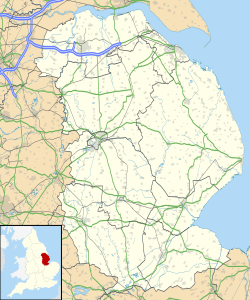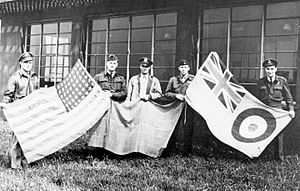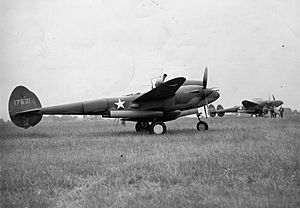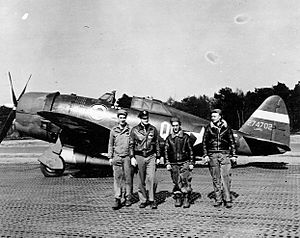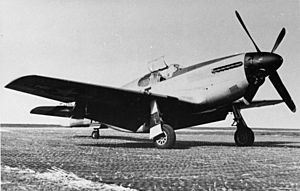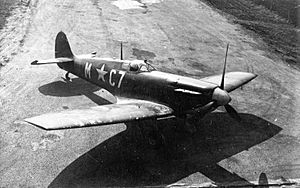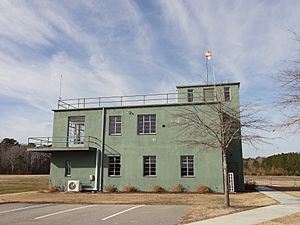RAF Goxhill facts for kids
Quick facts for kids RAF GoxhillUSAAF Station 345 |
|||||||||||
|---|---|---|---|---|---|---|---|---|---|---|---|
| Goxhill, Lincolnshire in England | |||||||||||
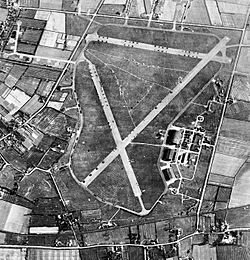
RAF Aerial photograph of Goxhill airfield. taken on 29 April 1947. The runways are blocked with different types of equipment. Also, the control tower and technical site with two T2 hangars and a J-Type hangar is on the right.
|
|||||||||||
|
Shown within Lincolnshire
|
|||||||||||
| Coordinates | 53°40′40″N 000°18′56″W / 53.67778°N 0.31556°W | ||||||||||
| Type | Royal Air Force station | ||||||||||
| Code | GX | ||||||||||
| Site information | |||||||||||
| Owner | Air Ministry | ||||||||||
| Operator | Royal Air Force United States Army Air Forces |
||||||||||
| Controlled by | RAF Bomber Command 1941 RAF Fighter Command 1941-42 1945- Eighth Air Force Ninth Air Force |
||||||||||
| Site history | |||||||||||
| Built | 1940/41 | ||||||||||
| Built by | John Laing & Son Ltd | ||||||||||
| In use | June 1941 - December 1953 | ||||||||||
| Battles/wars | European theatre of World War II | ||||||||||
| Airfield information | |||||||||||
| Identifiers | WMO: (grid reference TA110210) | ||||||||||
| Elevation | 6 metres (20 ft) AMSL | ||||||||||
|
|||||||||||
RAF Goxhill was a military airfield in Lincolnshire, England. It was located near the village of Goxhill, close to the Humber Estuary. This base was important during World War II, first for the British Royal Air Force (RAF) and later for the American United States Army Air Forces (USAAF).
Contents
Early Days of Goxhill Airfield
During the First World War, a small landing area for planes existed near Goxhill. Years later, in 1940, the Air Ministry (which managed the RAF) looked at the land again. They decided it was a good spot for a new airfield.
RAF Use During World War II
At first, Goxhill was used for barrage balloons. These were large balloons that floated in the sky, making it harder for enemy planes to fly low and attack the city of Hull and the nearby Humber river area.
In 1940, Goxhill was planned to become a bomber airfield. It was built with three main runways for planes to take off and land. It also had three large hangars (buildings to store and repair aircraft) and many parking spots for planes. There was enough space for over 1,700 people to live there.
However, the airfield was too close to Hull's defenses to be used for bombers. So, in June 1941, it became a training base. Planes like the Westland Lysander practiced towing targets for other pilots to shoot at. In December 1941, RAF Fighter Command took over. They used Supermarine Spitfires for fighter training until May 1942.
American Forces Arrive
In August 1942, the United States Army Air Forces (USAAF) took control of Goxhill. It became known as USAAF Station 345. General Dwight D. Eisenhower, who later became President of the USA, even attended the handover ceremony.
The living conditions at Goxhill were quite basic for the American troops. They lived in wooden and metal buildings. The living areas were about one to two miles away from the hangars. This was for safety reasons, in case of an attack. The American soldiers sometimes called the base "GoatHill."
Goxhill became a very important training airfield for the USAAF during the war. Many American fighter squadrons came here first to train after arriving in the UK. After their training, they would move to other bases for their combat missions.
Training Fighter Pilots
Both the 8th and 9th Air Forces of the USAAF used Goxhill for training. Here are some of the fighter groups that trained at Goxhill:
| Group | Aircraft | Date Arrived | Date Departed |
|---|---|---|---|
| 1st Fighter Group | Lockheed P-38 Lightning | 10 June 1942 | 24 August 1942 |
| 52nd Fighter Group | Bell P-39 Airacobra | 26 August 1942 | 9 November 1942 |
| 78th Fighter Group | P-38 Lightning P-47 Thunderbolt |
1 December 1942 | 6 April 1943 |
| 353rd Fighter Group | Republic P-47 Thunderbolt | 7 June 1943 | 3 August 1943 |
| 356th Fighter Group | P-47 Thunderbolt | 27 August 1943 | 5 October 1943 |
| 358th Fighter Group | P-47 Thunderbolt | 20 October 1943 | 29 November 1943 |
| 496th Fighter Training Group | North American P-51 Mustang P-38 Lightning |
25 December 1943 | 15 February 1945 |
The 496th Fighter Training Group was especially important. It was a "Combat Crew Replacement Center." This means it trained new fighter pilots for both the 8th and 9th USAAF units. This group trained over 2,400 fighter pilots during its time at Goxhill.
After the War
On January 20, 1945, the USAAF gave Goxhill back to the RAF. It was then used as a storage site for extra military equipment. RAF Goxhill stopped being an active military base on December 14, 1953.
After its military use, the airfield was rented out to farmers for growing crops. In 1962, the Ministry of Defence sold most of the land. However, they kept the main buildings and hangars for storage until 1977, when these were also sold to private owners for farming.
Goxhill Today
Even today, much of the old Goxhill airfield still looks like it did during the war. Many of the original buildings are still standing, including the three hangars. A large part of the runways and the paths for planes are also still there.
In one corner of the site, there is a memorial. It includes a propeller blade from a P-38 plane that crashed there. The old control tower was partly taken down in 2002. Its pieces were carefully moved to the Military Aviation Museum in Virginia, USA. There, the tower was rebuilt and is now part of the museum.
See also
- List of former Royal Air Force stations




